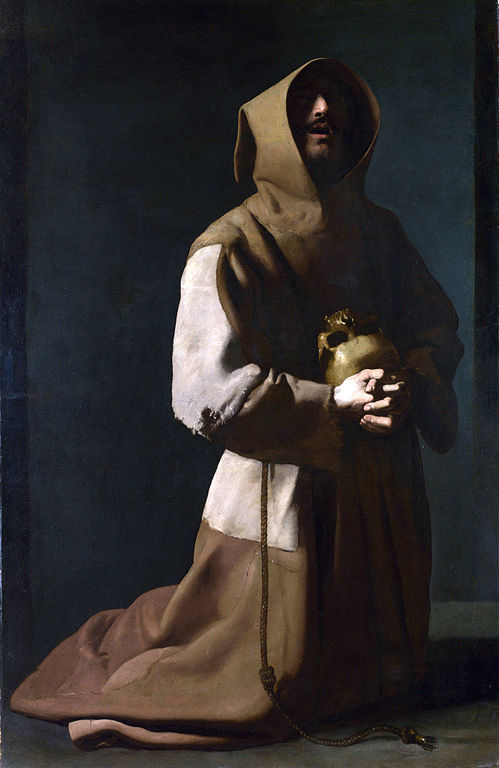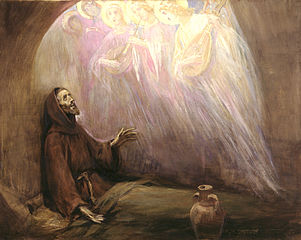 The fact that, during his lifetime, Saint Francis of Assisi (1182 – 1226) enjoyed a deeply personal connection to all aspects of creation has been documented thoroughly over the eight centuries since his death. Stories and legends abound surrounding his interactions with elements of the natural world and creatures of all kinds.
The fact that, during his lifetime, Saint Francis of Assisi (1182 – 1226) enjoyed a deeply personal connection to all aspects of creation has been documented thoroughly over the eight centuries since his death. Stories and legends abound surrounding his interactions with elements of the natural world and creatures of all kinds.
What is sometimes underplayed in Francis’ story is what today would be referred to as “the big picture.” In the case of the Little Poor Man of Assisi, the big picture was composed, solely and totally, of the Lord God Himself. Rejoicing in the beauty Francis saw all around him, sharing the sparsest of meals with his Brothers, even suffering grievously through the harsh vagaries of weather — all were occasions to give glory to God for the wonders of His Creation. The Lord God was the totality of Francis’ world: of, in, around, and throughout all things.
Convincing evidence of Francis’ all-consuming reverence for both Creator and Creation can be found in the song he composed near the end of his earthly life. Entitled Canticle of the Sun, or sometimes Canticle of the Creatures, this is probably the most well-known of Francis’ compositions.
“This magnificent hymn expresses the mystical vision of the Saint of Assisi and, since it springs from the depths of his soul, provides us with many insights into the profundity of his life of faith in the Triune God, Who so deeply enters into creation” (Francis and Clare: The Complete Works).
As to the timing of Francis’ composition, It is important to note that as the end of his time on earth approached, he grew more and more desperately ill. One of his greatest physical trials was a disease of the eyes which in the end rendered him blind.
It is difficult to imagine the tragedy of blindness for one who gloried constantly in the wonders of God’s Creation, from the vast expanse of sky, to the hills of his beloved Umbria, to the tiniest insect at his feet.
 For Francis, however, it was as if his physical inability to see brought to light a vision far deeper and more profound. So it was that with the eyes of his soul, Francis “saw” the words the world still reveres eight hundred years later.
For Francis, however, it was as if his physical inability to see brought to light a vision far deeper and more profound. So it was that with the eyes of his soul, Francis “saw” the words the world still reveres eight hundred years later.
Francis composed his Canticle in three sections separated by periods of time, dictating them for others to transcribe due to his failing eyesight. The song begins with verses of praise for various aspects of Creation:
Most High, all-powerful, good Lord,
Yours are the praises, the glory, the honor, and all blessing.
To You alone, Most High, do they belong,
and no man is worthy to mention Your name.
Praised be You, my Lord, with all Your creatures,
especially Sir Brother Sun,
Who is the day and through whom You give us light.
And he is beautiful and radiant with great splendor;
and bears a likeness of You, Most High One.
Praised be You, my Lord, through Sister Moon and the stars,
in heaven You formed them clear and precious and beautiful.
Praised be You, my Lord, through Brother Wind,
and through the air, cloudy and serene, and every kind of weather
through which You give sustenance to Your creatures.
Praised be You, my Lord, through Sister Water,
which is very useful and humble and precious and chaste.
Praised be You, my Lord, through Brother Fire,
through whom You light the night
and he is beautiful and playful and robust and strong.
Praised be You, my Lord, through our Sister Mother Earth,
who sustains and governs us,
and who produces varied fruits with colored flowers and herbs.
This second section was written in 1226, during a time of local conflict between religious and civil authorities in Assisi. This situation grieved Francis tremendously:
Praised be You, my Lord, through those who give pardon for Your love
and bear infirmity and tribulation.
Blessed are those who endure in peace
for by You, Most High, they shall be crowned.
In his biography of Saint Francis, Omer Englebert relates the quarreling officials’ response to this message of peace: “They separated completely reconciled; and thanks to Francis, charity and peace won out once more among the people of Assisi.”
The third and final section came to be as Francis’ earthly life drew to its close:
Praised be You, my Lord, through our Sister Bodily Death,
from whom no living man can escape.
Woe to those who die in mortal sin.
Blessed are those whom death will find in Your most holy will,
for the second death shall do them no harm.
Praise and bless my Lord and give Him thanks
and serve Him with great humility.
Sung by Francis’ closest friends as he lay dying, their grief apparent in every word, his song gave testament to the religious life he had lived, with his Lord God ever at his side.
Echoing through the centuries, the influence of Canticle of the Sun can be found in an encyclical penned by the successor of Peter in our own time. Issued in 2015, Laudato Si takes its title from words repeated throughout Saint Francis’ song: Praised Be You.
“In the words of this beautiful Canticle,” writes Pope Francis, “Saint Francis of Assisi reminds us that our common home is like a sister with whom we share our life and a beautiful mother who opens her arms to embrace us.”
The Holy Father reminds us of our accountability for our environment and of our responsibility to safeguard it for ourselves and for all creatures. He voices concern for environmental challenges and their possible impact on the future of our planet.
From his place in heaven, Saint Francis of Assisi surely agrees.
© All Rights Reserved, Living His Life Abundantly®/Women of Grace® http://www.womenofgrace.com









